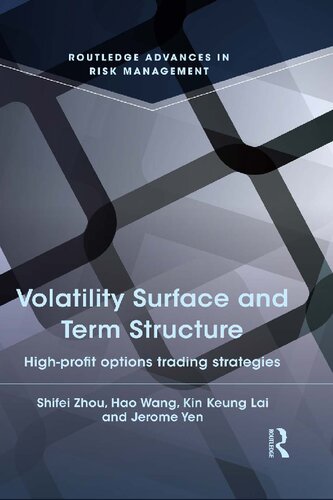

Most ebook files are in PDF format, so you can easily read them using various software such as Foxit Reader or directly on the Google Chrome browser.
Some ebook files are released by publishers in other formats such as .awz, .mobi, .epub, .fb2, etc. You may need to install specific software to read these formats on mobile/PC, such as Calibre.
Please read the tutorial at this link. https://ebooknice.com/page/post?id=faq
We offer FREE conversion to the popular formats you request; however, this may take some time. Therefore, right after payment, please email us, and we will try to provide the service as quickly as possible.
For some exceptional file formats or broken links (if any), please refrain from opening any disputes. Instead, email us first, and we will try to assist within a maximum of 6 hours.
EbookNice Team

Status:
Available4.4
17 reviews
ISBN 10: 0415826209
ISBN 13: 9780415826204
Author: Kin Keung Lai, Jerome Yen, Shifei Zhou, Hao Wang
This book provides different financial models based on options to predict underlying asset price and design the risk hedging strategies. Authors of the book have made theoretical innovation to these models to enable the models to be applicable to real market. The book also introduces risk management and hedging strategies based on different criterions. These strategies provide practical guide for real option trading. This book studies the classical stochastic volatility and deterministic volatility models. For the former, the classical Heston model is integrated with volatility term structure. The correlation of Heston model is considered to be variable. For the latter, the local volatility model is improved from experience of financial practice. The improved local volatility surface is then used for price forecasting. VaR and CVaR are employed as standard criterions for risk management. The options trading strategies are also designed combining different types of options and they have been proven to be profitable in real market. This book is a combination of theory and practice. Users will find the applications of these financial models in real market to be effective and efficient
1 Introduction
1.1 Implied volatility
1.2 Local volatility model
1.3 Stochastic volatility model
2 A novel model-free term structure for stock prediction
2.1 Introduction
2.1.1 Background
2.1.2 Motivation
2.2 Volatility model
2.3 Model-free term structure
2.3.1 Model-free implied volatility
2.3.2 Distribution of the price of the underlying asset
2.4 Empirical tests
2.4.1 CEV model
2.4.2 Empirical analysis
2.4.2.1 Data description
2.4.2.2 Heston and CEV simulation
2.5 Conclusions
3 An adaptive correlation Heston model for stock prediction
3.1 Introduction
3.1.1 Background
3.1.2 Motivations
3.2 Adaptive correlation coefficient model
3.2.1 Adaptive correlation Heston model
3.2.2 Distribution of the underlying asset price
3.3 Empirical tests
3.3.1 CEV model
3.3.1.1 Empirical analysis
3.4 Conclusions
4 The algorithm to control risk using options
4.1 Introduction
4.2 Theoretical background and model
4.2.1 Theoretical background
4.2.2 A risk management model
4.2.2.1 Risk management model using put option
4.2.2.2 Risk management model using call option
4.3 Discussion
4.3.1 Advantages of method one
4.3.2 Disadvantages of method one
4.3.3 Advantages of method two
4.3.4 Disadvantages of method two
4.4 Conclusions
5 Option strategies Evaluation criteria and optimization
5.1 Introduction
5.2 Theoretical background and model
5.2.1 The model of basic style
5.2.2 The model of the composite style
5.3 Results
5.4 Conclusions
6 A novel mean reversion-based local volatility model
6.1 Introduction
6.2 Motivations
6.3 Mean reversion-based local volatility model
6.3.1 Local volatility model
6.3.2 Mean-reversion process
Proof
6.4 Local volatility surface
6.5 Empirical tests
6.6 Conclusions
7 Regression-based correlation modeling for the Heston model
7.1 Introduction
7.2 The Heston model
7.3 Regression-based correlation coefficient
7.3.1 Simple regression
7.3.2 Polynomial regression
7.3.3 Autoregressive model
7.4 Empirical tests
7.5 Conclusions
8 Index option strategies Comparison and self-risk management
8.1 Introduction
8.2 Review
8.3 Theoretical background and model
8.4 Results and analysis
8.5 Conclusions
Appendix
9 Call–put term structure spread-based Hang Seng Index analysis
9.1 Introduction
9.2 Theoretical background and model
9.2.1 Data
9.2.2 Theoretical background
9.2.3 Model
9.3 Results and analysis
9.4 Conclusions
Notes
2 A novel model-free term structure for stock prediction
6 A novel mean reversion-based local volatility model
References
Index
volatility surface book
the volatility surface
volatility surface dynamics
volatility surface explained
volatility surface example
the volatility surface a practitioner's guide
the volatility surface a practitioner’s guide
Tags: Kin Keung Lai, Jerome Yen, Shifei Zhou, Hao Wang, Volatility, Surface